
The Beano is a British anthology comic magazine created by Scottish publishing company DC Thomson. Its first issue was published on 30 July 1938, and it published its 4000th issue in August 2019. Popular and well-known comic strips and characters include Dennis the Menace, Minnie the Minx, The Bash Street Kids, Roger the Dodger, Billy Whizz, Lord Snooty and His Pals, Ivy the Terrible, General Jumbo, Jonah, and Biffo the Bear.

Action Comics is an American comic book/magazine series that introduced Superman, one of the first major superhero characters. The publisher was originally known as Detective Comics Inc., which later merged into National Comics Publications, before taking on its current name of DC Comics. Its original incarnation ran from 1938 to 2011 and stands as one of the longest-running comic books with consecutively numbered issues. The second volume of Action Comics beginning with issue #1 ran from 2011 to 2016. Action Comics returned to its original numbering beginning with issue #957.

The Topper was a UK comic published by D. C. Thomson & Co. Ltd that ran from 7 February 1953 to 15 September 1990, when it merged with The Beezer.

A British comic is a periodical published in the United Kingdom that contains comic strips. It is generally referred to as a comic or a comic magazine, and historically as a comic paper. As of 2014, the three longest-running comics of all time were all British.

The Superman Family is an American comic book series published by DC Comics from 1974 to 1982 featuring supporting characters in the Superman comics. The term "Superman Family" is often used to refer to the extended cast of characters of comics books associated with Superman. A similarly titled series, Superman Family Adventures, was published in 2012.
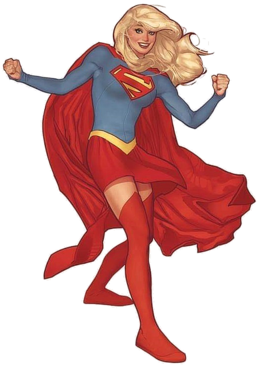
Kara Zor-El (Supergirl) also known by her adoptive names of Linda Lee, Kara Kent, Linda Lang, and Kara Danvers, is a superheroine appearing in American comic books published by DC Comics. She was created by Otto Binder and designed by Al Plastino. Danvers first appeared in the story "The Supergirl from Krypton" in Action Comics #252. Kara is the biological cousin of Kal-El, who went on to adopt the name of Clark Kent and the superhero identity Superman. Her father, Zor-El, is the brother of Superman's father, Jor-El. During the 1980s and the revolution of the Modern Age of Comics, Superman editors believed the character's history had become too convoluted, thus killing Supergirl during the 1985 Crisis on Infinite Earths event and retconning her out of existence.

Aspen Comics is a California entertainment company founded in 2003 by artist Michael Turner. It has locations in Santa Monica and Marina Del Rey. The company is best known for producing comic books and figurines.
Joey Cavalieri is an American writer and editor of comic books. He is best known for his work on the characters Green Arrow and Huntress as well as the co-creation of Helena Bertinelli, the third Huntress, for DC Comics.

Power Comics was an imprint of the British comics publisher Odhams Press that was particularly notable for its use of material reprinted from American Marvel Comics. Appearing chiefly during the years 1967 and 1968, the Power Comics line consisted of five weekly titles: Wham!, Smash!, Pow!, Fantastic and Terrific. The first three of these titles were essentially traditional The Beano-style British comics papers, supplemented by a small amount of Marvel and DC Comics material, while Fantastic and Terrific were more magazine-like in style and were dominated by their Marvel superhero content.
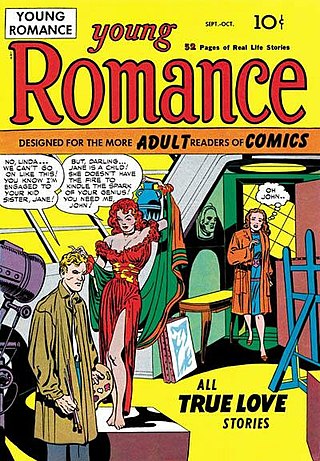
Romance comics are a genre of comic books that were most popular during the Golden Age of Comics. The market for comics, which had been growing rapidly throughout the 1940s, began to plummet after the end of World War II when military contracts to provide disposable reading matter to servicemen ended. This left many comic creators seeking new markets. In 1947, part of an effort to tap into new adult audiences, the romance comic genre was created by Joe Simon and Jack Kirby with the Crestwood Publications title Young Romance.

Australian comics have been published since 1908 and Australian comics creators have gone to produce influential work in the global comics industry,
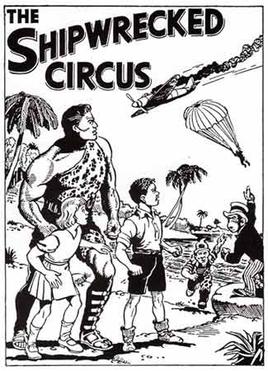
Paddy Brennan is an Irish comics artist who worked mainly in the UK, drawing adventure strips for D. C. Thomson & Co. titles. He was a freelancer, working six months of the year in Dublin and six months in London.
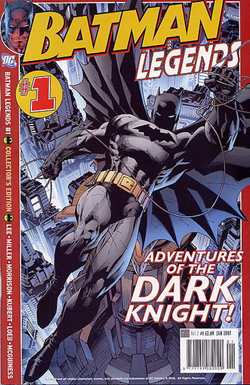
Batman Legends was a monthly anthology comic book series published in the UK by Titan Magazines as part of their DC Comics 'Collector's' Edition' range. Initially published by Panini Comics for 41 issues between October 2003 and November 2006, Titan subsequently took over publication with the launch of the comic's second volume. The title reprinted Batman-related comics originally published by DC Comics in the United States, typically including three stories per issue in a serialised format.

Supergirl is the name of seven comic book series published by DC Comics, featuring various characters of the same name. The majority of the titles feature Superman's cousin Kara Zor-El.
Notable events of 1967 in comics.

Princess Tina was a British weekly girls' comic anthology published by Fleetway Publications and IPC Magazines from 23 September 1967 to 12 January 1974. The comic was created by combining two underperforming Fleetway titles — Princess and Tina — into a third, new comic. Notable strips included the long-running family drama "The Happy Days" and "Patty's World". The latter would outlive Princess Tina, continuing after the comic was merged into Pink.
British girls' comics flourished in the United Kingdom from the 1950s through the 1970s, before beginning to decline in popularity in the 1980s and 1990s. Publishers known for their girls' comics included DC Thomson and Fleetway/IPC. Most titles appeared weekly, with the content primarily in picture-story format. The majority of the stories were serialized, with two or three pages per issue, over eight to twelve issues. They were marketed toward young teen girls.
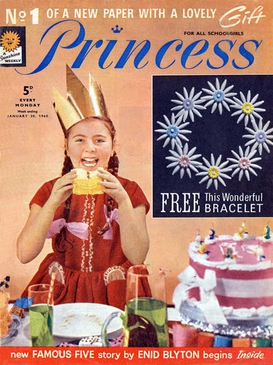
Princess was a British weekly girls' comic anthology published by Fleetway Publications and, later, IPC Magazines. The first version was published between 30 January 1960 and 16 September 1967, and featured a mix of comic strips, text stories and a large proportion of features; it was merged with Tina to form a new title - Princess Tina - after 399 issues.

June was a British weekly girls' comic anthology published by Fleetway Publications and IPC Magazines from 18 March 1961 to 15 June 1974. Designed as a response to DC Thomson's hit Bunty, June never quite eclipsed its Scottish rival but was nevertheless a success on its own terms, reaching 631 issues before being merged into Tammy in 1974.
















